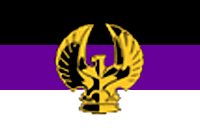Flag of Starblaydia

| |
| Proportion | 3:2 |
| Adopted | 6th April, 1972 |
| Design | A black, purple and blue horizontal tricolour with gold stylised eagle |
The Flag of Stablaydia consists of a three horizontal stripes, coloured black (top), purple (middle) and white (bottom), with a stylised golden eagle displayed in the centre. The design is based on the heraldry of the semi-mythical King Oberyn, an important figure in Starblaydi culture and history who probably lived around the time of the birth of Christ.
His heraldry was made into Starblaydia's flag when it gained independence in 1946, before being modified slightly with a heraldic device in 1972.
History
As a colony
The original flag of Starblaydia was far more simple than that of the preent day. A field of purple - like Oberyn's - taken from the colour of the Starblaydi Orchid, with the cross of Starblaydia's patron saint - Saint George - as a canton (a square in the upper-left corner). It was originally put in place by the Britannican Empire in 1892 to mark Starblaydia as a colonial province of the Britannican Empire, and existed for just over fifty years.
Independence
</div>After two global wars, the Britannican Empire knew that they could no longer hold on to all their colonial possessions. With public pressure both at home in the Empire and also in Starblaydia pushing for independence, the Empire finally decided to cede control of the colony to a local parliament. The new nation needed a flag, and ancient archives and texts provided them with a design. According to legend, King Oberyn wielded "an impressive, now mythical, sword that the Romanics knew as Fulguritus Acinace, the Lightning-struck Sabre". Known as Oberyn Star-blade, the emergence of heraldry in the Daii soon required that Oberyn defined his coat of arms. The colours that formed them, black, purple and white, were formed into Starblaydia's first independent Tricolour on August 23rd, 1946.
Modern
When Saevion Starblayde took complete control of the nation in the 1970s, he decided that a simple horizontal tricolour, even with the unique Starblaydi Orchid purple, was not distinctive enough. He decided to add the charge of a stylised eagle - King Oberyn's symbol - in gold into the centre of the flag, overlapping all three colours to symbolise the re-unification of the nation. The Eagle represented the God of moral law and order, protector of suppliants and punisher of guilt, something which was equated with not only Oberyn himself, but also Saevion and the dictatorship that he wished to implement. The symbol is also known as the 'Oberyn Eagle'.
Useage

The Starblaydi flag, and elements of it, appear throughout Starblaydi society. In the first instance it is used to brand Starblaydia and the Starblaydi people throughout the country, a tool of the dictatorial regime to implant the thought in people's minds that Starblaydia - and by association its Lord-Protector - was omnipresent and omnipotent.
The 'Oberyn Eagle' is also used on the flag of Nova Britannicus, symbolising Starblaydia's dominance over their neighbours.
The burning of the Starblaydi flag is not considered an offence, merely in bad taste. Should anyone, particularly a foreigner, burn the 'black, white and purple' they are considered cowardly; setting fire to a mere piece of material instead of showing the courage of attacking Starblaydia itself.


